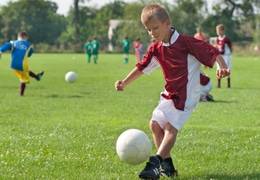Avoid Hazards on the Road to Raising Young Athletes

The ability to visually track moving objects usually doesn’t mature in kids until age 8 or 9, according to Scripps Clinic sports medicine pediatrician Dr. Paul Stricker.
The road to raising young athletes today often seems filled with hazardous conditions.
“There are a lot of myths out there about the best ways to help kids excel in sports,” said Dr. Paul Stricker, a Scripps Clinic sports medicine pediatrician and former U.S. Olympic team physician.
According to Dr. Stricker, learning the facts about the following key areas can help pave the way to a healthier youth sports experience.
1. Entering the game. Starting a child’s sports career at an early age may seem like a smart way to get ahead. But research shows that beginning very young – age 4 or sooner – provides no benefit to future sports performance and may contribute to injuries and burnout. Kids build their sports skills in a progressive sequence that can’t be dramatically sped up. Motor skills such as balance and running don’t fully develop until age 6 or 7, while the ability to visually track moving objects doesn’t mature until age 8 or 9.
2. Hitting the weights. Working out with moderate weights usually starts to provide the most strength benefits once kids reach puberty (age 13 to 15 for boys, 11 to 13 for girls). This is when they have the hormones to allow their muscles to get significantly bigger and stronger. Before puberty, some low-weight strength training may be done – but only for purposes of injury prevention and always under careful adult supervision. Heavy weights should be avoided until kids have gone through most of their rapid growth.
3. Battling the pain. When muscle and joint pain arises, some parents give their kids anti-inflammatory medications before practices or games so they don’t miss playing time. But these medications only block the chemical process that produces inflammatory pain, so continuing the activity simply puts more stress on the already-injured tissue. By masking important symptoms, kids run the risk of experiencing more extensive injuries and more time away from the action. Ice is preferable to anti-inflammatory drugs as a first-line treatment for pain after activity or injury.
4. Fueling the fire. Maintaining a healthy diet is often challenging, so many people try to fill the gap by taking multivitamins. Despite their convenience, vitamin tablets simply cannot replicate the healthy nutrients found in fruits and vegetables. The benefits of eating healthy include stronger bones and muscles, improved oxygen delivery, a strengthened immune system and better ability to recover for the next workout.
Scripps has been the official health care provider to the Padres since 1981. To find a Scripps physician, call 1-800-SCRIPPS.
Media Contact
- Steve Carpowich
- 858-312-0328
- carpowich.stephen@scrippshealth.org
- Follow me: @Carpowich